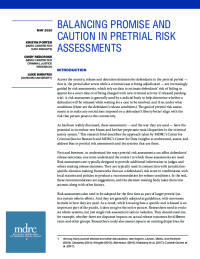Balancing Promise and Caution in Pretrial Risk Assessments

Across the country, release and detention decisions for defendants in the pretrial period — that is, the period after arrest while a criminal case is being adjudicated — are increasingly guided by risk assessments, which rely on data to estimate defendants’ risk of failing to appear for a court date or of being charged with new criminal activity if released pending trial. A risk assessment is generally used by a judicial body to help determine whether a defendant will be released while waiting for a case to be resolved, and if so, under what conditions (these are the defendant’s release conditions). The goal of pretrial risk assessments is to make any restrictions imposed on a defendant’s liberty better align with the risk that person poses to the community.
As has been widely discussed, these assessments — and the way they are used — have the potential to introduce new biases and further perpetuate racial disparities in the criminal justice system. This research brief describes the approach taken by MDRC’s Center for Criminal Justice Research and MDRC’s Center for Data Insights to understand, assess, and address bias in pretrial risk assessments and the systems that use them.






